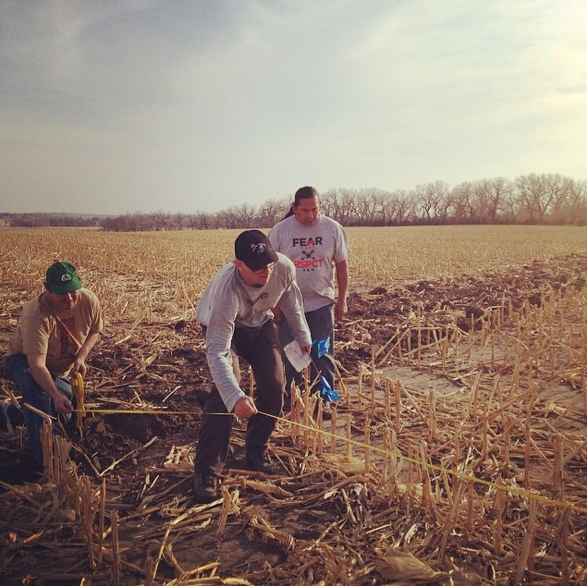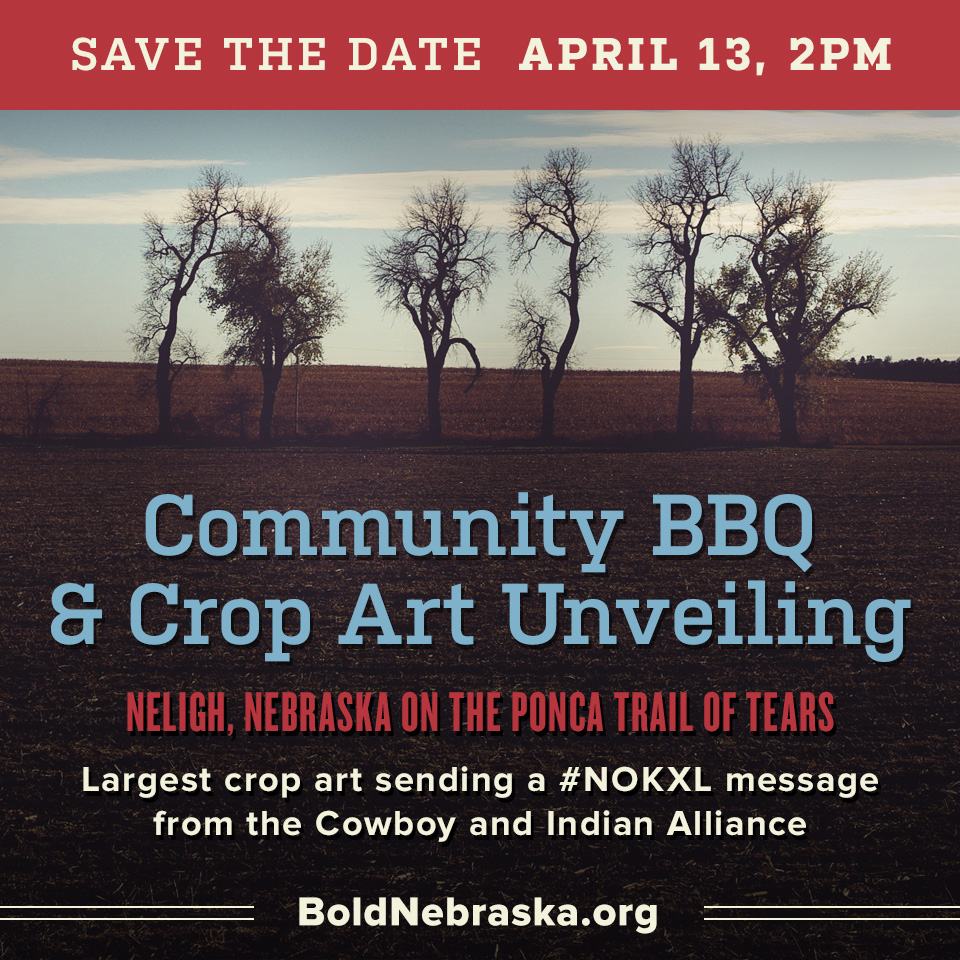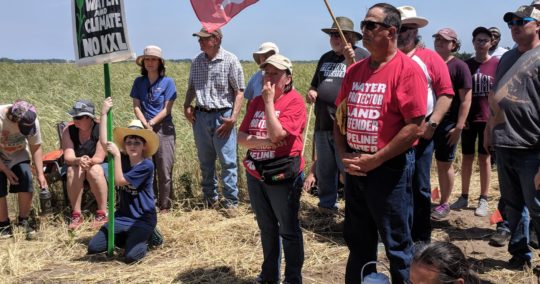Artist John Quigley has partnered with the Cowboy and Indian Alliance to create the world’s largest crop art installation, on land in Neligh, Nebraska on the Ponca Trail of Tears that would be traversed by the Keystone XL pipeline. The crop art installation will send President Obama a direct #NoKXL message from the Cowboy and Indian Alliance.
AERIAL IMAGES OF THE CROP ART FOR USE BY MEDIA:
Image #1: https://www.flickr.com/photos/boldnebraska/13828142263
Image #2: https://www.flickr.com/photos/boldnebraska/13828131773
LINKS TO DOWNLOAD B-ROLL AERIAL VIDEO OF THE CROP ART & SUNDAY EVENT:
Aerials: http://bit.ly/1iq1LAn (via Google Drive)
Ceremony in field: http://bit.ly/1iq1LAn
Tractor: http://bit.ly/1m81HZ0
Water ceremony: http://bit.ly/1mdLNdj
Cowboy and Indian Alliance Sends President Obama
Huge #nokxl Message from the Heartland
Crop Art Size of 80 Football Fields
Kicks-Off Reject and Protect Events
Neligh, Nebraska — The Cowboy and Indian Alliance created a crop art image, the size of 80 football fields, to send President Obama a message to protect the Heartland by rejecting the Keystone XL tarsands pipeline. Tribes, farmers and ranchers are now headed to Washington, DC for a week-long series of actions called Reject and Protect. The image was created by artist John Quigley and was inspired by tribal artist Richard Vollaire of the Tongva Nation.
The crop art is directly on the proposed path of Keystone XL, which also crosses the Ponca Trail of Tears. Landowner Art Tanderup said, “This land has been in our family for over 100 years. We have always been stewards of the land. The soil is very sandy here, any leak would leach into the Ogallala Aquifer contaminating our water without any concrete plan to clean up the pollution. With this crop art we are literally drawing a line in the sand and asking President Obama to stand with our families.”
The massive crop design of a cowboy and Indian warrior includes key images of water and a hashtag made of arrows. A sun with seven rays depicts the tribal tradition of protecting seven generations and the renewable energy farmers, ranchers and tribes want to see on their land rather than a tarsands pipeline that risks their water. The aerial image was taken over Art and Helen Tanderup’s land in a crop duster plane from 3,000 feet. Art Tanderup dug the image lines with his tractor following the direction of flags planted by volunteers and artistic on-the-ground direction of John Quigley.
“Americans always go big when they’re pushed to their limits. This image, which may well be the largest crop art ever, sends the message that the good people of the Heartland have the courage to stand up for their rights to clean water. They reject the bullying of TransCanada and will defend their land,” said artist John Quigley.
The Keystone XL route crosses the Ponca Trail of Tears without a proper cultural analysis from the state of Nebraska or the US State Department. Aldo Seoane with the Rosebud Sioux Tribe said, “The United States and TransCanada have consistently and intentionally disregarded the concerns of tribal nations and concerned citizens. We as tribal people have been here since the beginning of time and we have seen the best and worst of what people can create. This pipeline is certainly the worst thing that can happen to our land, our water and our people.”
The series of actions called Reject and Protect will take place April 22-27 in Washington, DC. Landowners and tribes share a common goal of protecting the land and water from risky projects like the Keystone XL tarsands pipeline. Jane Kleeb of Bold Nebraska put the action into context, “President Obama has deep family roots in the Heartland and was adopted into a tribal family. It’s too easy in Washington to only think about politics. Our families may not contribute millions to candidates, but we do put food on America’s table and can only do that with clean water that is tarsands-free.”
“President Obama and Secretary Kerry have a chance to stand with Americans concerned about their livelihoods and their futures. They can choose to listen to these voices and reject Keystone XL or they can choose to bow to the pressures of Big Oil bent on jamming this pipeline through our nation’s Heartland,” said David Turnbull, Campaigns Director of Oil Change International.
More Info:
Artist John Quigley and Spectral Q: www.SpectralQ.com
Bold Nebraska: www.boldnebraska.org
Rosebud Sioux Tribe: http://www.shieldthepeople.org
Cowboy and Indian Alliance/ Reject and Protect: www.rejectandprotect.org
Oil Change International: www.priceofoil.org
Picture Caption: A huge crop art image protesting the proposed Keystone XL pipeline covers an 80 acre corn field outside of Neligh, Nebraska on April 12, 2014. The image, which lies on the proposed pipeline route that crosses the Ponca Trail of Tears, was created by the farmers, ranchers and Native American tribes of the Cowboy and Indian Alliance in collaboration with artist John Quigley. Photo by Lou Dematteis
###
CROP ART NEWS STORY FROM WOWT-TV OMAHA, NE:
//
PHOTOS FROM THE CROP ART INSTALLATION:


(A huge crop art image protesting the proposed Keystone XL pipeline covers an 80 acre corn field outstide of Neligh, Nebraska on April 12, 2014. The image, which lies on the proposed pipeline route that crosses the Ponca Trail of Tears, was created by the farmers, ranchers and Native American tribes of the Cowboy and Indian Alliance in collaboration with artist John Quigley. Photo by Lou Dematteis / Spectral Q)


(Artist John Quigley and volunteers plot the #nokxl crop art design out in a corn field near Neligh, NE. Photo by Ben Gotschall)


(Tape and flags for the #nokxl crop art. One 200 x 1000 foot strip down, 9 more to go. Photo by Ben Gotschall)


(Wayne with the Rosebud Sioux and Gary with the Nez Perce helping out with #nokxl crop art. Photo by Jane Kleeb)


(Creating hashtags for #nokxl message to @BarackObama from Cowboy and Indian Alliance. Photo by Jane Kleeb)


(The “paintbrush” for the #nokxl cropart. Photo by Jane Kleeb)
Join us on April 13 at 2:00 p.m. for a Community BBQ and unveiling of the artwork — RSVP on the form below.
Along with the artwork unveiling, the BBQ will also serve as a “Bon Voyage” party for the caravan delivering tipis and Nebraska families’ well water from the Ogallala Aquifer to Washington, D.C. for the Reject + Protect event there April 22-27.
DIRECTIONS:
- From Neligh: 8 miles north on HWY 14 to 857 RD, west 2/3 of a mile, then north up the lane
- From the junction of HWY 20 and HWY 14: 7 miles south on HWY 14 to 857 RD, west 2/3 of a mile, then north up the lane
About artist John Quigley:
John Quigley, the Founder of Spectral Q, is an internationally known Artist and Producer. His unique mix of human installation and aerial photography brings together communities to create large-scale messages for the common good. He has created more than 200 Aerial Art images involving over 200,000 people on 7 continents. Locations have ranged from the Amazon Rainforest, Antarctica, London, Geneva, Athens, Delhi, Johannesburg, Copenhagen, Bonn, Victoria, Toronto, Mexico City, Australia, Java, Bali, Chile, Belize, Peru, Ecuador, Brazil, Alaska, Vancouver, the Arctic, Los Angeles, cities across the United States, and the United Nations in New York. In 2008 he began the Icon Series with aerial portraits of Nelson Mandela (as part of the 90th Birthday celebrations in South Africa) and Martin Luther King Jr. on behalf of Amnesty International and The Elders. In 2011 his ‘Melting Vitruvian Man’ near the North Pole generated widespread global media attention.
About the Farm:
Art and Helen Tanderup’s farm land is in Custer Township in Antelope County Nebraska. The land has been in Helen’s family for 100 years and they continue to honor the family’s ethic of good stewardship by not tilling the land and using sound water conservation and farming techniques. They hope to pass the farm on to their two children and grandchildren and fear that the KXL pipeline threatens their family legacy. Their land is directly on the Ponca Trail of Tears and the proposed route crosses this sacred site. Bold Nebraska, the Brave Heart Society along with families from the proposed route, the Ponca tribe and the Sioux tribe all gathered for a spiritual camp on this land to come together and pray for our common purpose–to protect the land and water.
About the Cowboy and Indian Alliance:
Tribes and rural families are working together to protect what is sacred–our land and water. We call it the Cowboy and Indian Alliance. Farmers and ranchers know the risk first-hand. They work the land every day. Tribes know the risk first-hand. They protect the sacred water, and defend sacred sites of their ancestors every day. They have united out of love and respect for the land and water on which we all depend. This is not the first time Cowboys and Indians have come together to stop projects that risk our land and water. In the 80s, they came together to protect water and the Black Hills from uranium mining and risky munitions testing. In the American imagination, cowboys and Indians are still at odds. However, in reality, opposition to the Keystone XL tar sands pipeline has brought communities together like few causes in our history. Tribes, farmers and ranchers are all people of the land, who consider it their duty as stewards to conserve the land and protect the water for future generations.






